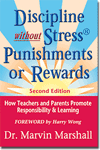|
 |
| Teachers.Net Gazette Vol.6 No.1 | January 2009 |
Subscribe for free home delivery |
|
Teaching is an art, not a science. There are many things in life that everyone knows exist but that cannot be quantified. Love and friendship are but two simple examples. | |
| by Dr. Marvin Marshall www.MarvinMarshall.com Regular contributor to the Gazette January 1, 2009 |
|
|

Educational theorists have attempted to bring the educational profession to the same status as professionals in the physical and biological sciences. This is exemplified by using the same criteria for teaching as is used in the physical sciences. For example, in order for a new project to be federally funded, a pre and post or an experimental and control approach is required. As you read the following recent communication to me, reflect on how it would fit into the "scientific" mode: Greetings from Benchmark School in Phoenix! I have been using your program for over 5 years now and am still amazed at how wonderful it is. This year I was given the tough class—the class that no teacher has ever been able to control. It was a tough go at first. This particular group of children has had control of their teachers for years. I am happy to say that we are now in control. My teaching partner (not familiar with your program) thought that we were putting in so much effort and time at the start of the year to teach procedures and the levels, but the students were still terrible. I promised her that if she stuck with it and stayed consistent that they would come around, and I am proud to say they have. My partner is amazed at how we spend so much time teaching now and not disciplining. We have also heard from parents of students who always made good choices that this year was a great year because the other kids don’t do what they have always have done. Their children love coming to school because I am not punishing the entire class for the poor choices of the other students. I hold each person accountable for his/her own behavior. Another thing I wanted to share with you is how the parents reacted at conferences. Many of the parents shared that their child was now acting more responsibly at home—especially getting home assignments done without fights. I hear this every year and I believe that because the students are being guided to be more responsible citizens at school that they are carrying it into their lives at home.
Thank you again, How do you measure or quantify success such as this? Here is another example using the Discipline Without Stress Teaching Model. Part I --How do you quantify the implementation of procedures? Part II --How do you quantify communicating to students in positive, rather than in negative, terms? --How do you quantify the constant use of choice to reduce coercion and increase desire to both behave responsibly and reduce apathy in learning? --How do you quantify the constant use of reflection to motivate and prompt behavior change? Part III --How do you quantify the constant reference to the Levels of Social Development and implantation of the significant points? --How do you quantify Checking for Understanding? --How do you quantify Guided Choices? Part IV --How do you quantify using the hierarchy to promote effort in learning? Bill Page, a contributor to the Gazette, has a set of DVD’s that could substitute for any college course designed to prepare prospective teachers for the classroom, K-12. If you were to view them (well worth the small investment) and ask yourself how can this artistry of teaching be quantified, you would be hard pressed to create a solution. Hopefully, the new United States 111th Congress and the new U.S. President’s administration will lead us down a path that will bring much needed change. The first step in this direction would be to recognize the art of teaching by using an appropriate yardstick. Copyright © 2009 Marvin Marshall. Additional information is available at www.MarvinMarshall.com
| |
|


 His approach is the only system that is proactive, totally noncoercive, and does not use external manipulatives or threats. He INDUCES students to WANT to act responsibly and WANT to put forth effort to learn.
His approach is the only system that is proactive, totally noncoercive, and does not use external manipulatives or threats. He INDUCES students to WANT to act responsibly and WANT to put forth effort to learn.
